Page 3
Correlations, Coincidences, or Compatible connections of a comparative cognition?
~ The Study of Threes ~
http://threesology.org
| Pages in this series: | ||
| Study of Threes page 1 | Study of Threes page 2 | Study of Threes page 3 |
Visitors as of 8/25/2018
A study of threes necessarily involves making a list of items exhibiting what a given researcher perceives to be an expression of "Three" whether it be singularly stated such as Earth being the third planet from the Sun or an example which explicitly describes a content of three things such as Goldilocks and the Three Bears (which actually is a 3-to-1 ratio pattern), or simply provides a series of three items such as the Gold-Silver-Bronze medals used in the Olympic games. While a list of items may give the impression of being top heavy with a reliance on letters, words, phrases, etc., there are numerous non-verbal expressions (acts/activities) which display explicit characterizations, fanciful caricatures or subtle hints of human cognition which can be perceived by a single sense (like a strong odor or whiff of perfume) or as the result of using more than one sense (sight, sound, taste, smell, touch). Nonetheless, speech and its developmental connection to the development of the human brain/mind and its resulting societal uses or disuses must be appreciably taken into consideration.
Note: In giving reference to the "3-to-1" ratio, it should be understood that this is a generic label standing in for overlapping 'specificities' such as a:
- "3-in-1" (Example: the Trinity of Christianity is sometimes referred to as 1 god in 3 divine persons (though other triads of gods could be similarly described); or the 3 "moments"...dawn-noon-dusk... in 1 Sun; or 3 brains/parts/sections {reptilian-paleomammalian-neomammilian} in 1 head called the Triune brain complex;
- "3-and-1" (Example: 3 cones and 1 rod differentiation in the human eye)... though three types of photoreceptor cells in mammalian eyes: rods, cones, and intrinsically photosensitive retinal ganglion cells.;
- "all-for-one" (Example: the three inseparable Musketeers group later joined by d'Artagnan who is not at first an actual Musketeer);
- "from-many-one" (or alternatively: "Out of many, one"; "One out of many"; "One from many")[Example: Slogan on U.S. currency in the phrase E pluribus unum;
- "one to/too/two many" (Example: supposed counting system of early peoples such as the The Piraha people; or as a reference to someone who is inebriated; or describing an unequal circumstance such as one person having to fight a group;
- "1-with-3" (Example: 1 pencil or pen is held by three fingers apparently by most people);
- "3-plus-1" (Example: both DNA and RNA have adenosine-cytosine-guanine plus the respective singularities thymine/uracil, or buy 3 tires and get 1 free);
- which includes varying semantic declarations such as 3-from-1; 3-minus-1; 3-multiplied by-1; 3-divided by-1; 3-changed by-1; 3-inserted into-1; 3-but-1; 3-nor-1; 3-nand-1; 3-maybe-1; 3-might be-1; 3-are-1; 3 will be-1; 3-can't be-1; 3-came from-1; etc..., necessarily enabled to be reversed or compiled with different indexing symbology such as [1-1-1 + 1]; [1 + 2/1]; [1/1 1/2 1/3: 0/1]; 3:1 (or 1:3); ABC-D; rock-paper-scissors/hand; etc...
Clearly, the "three" might be expressed with some other word or symbol grouping such as ABC, XYZ axes, III, 2-3-4, A2 + B2 = C2, etc., that is not customarily referred to as a trio, triad, treble, Ternary, Terzetto, Threefold, Threesome, Tierce, Trey, Tri, Triad, Triadicity, Tricameralism, Trichotomy, Trine, Trinity, Trinitarian, Trio, Triple, Triplet, Triscale, Triunity, Troka, etc., or involve a series of what to others is a taken-for-granted group-of-three because they occur in different places at different time periods and no one has identified the individually occurring events as being related... to the extent the group of three is widely recognized. References to what constitute a pattern-of-three can take on an artificialized time and distance factoring unless some historian distinguishes a connection based on whatever criteria their particular research model uses.
In my study of the 'Threes Phenomena', I encounter numerous patterns-of-three which are defined as patterns-of-two. This "two versus three" difference of opinion has a long history. As an example, the following is an image of two Roman dicers having a disagreement about a particular occurrence taking place in their game, since the interpretation of what is being represented will determine one or the other's increased pecuniary or social value:

Buckland's Third Revolution Poster column 8
Another example which is in vogue and has been (I will venture to guess) since the inception of infant vocalization research was deemed an important area of studying cross-cultural linguistics (Ethnolinguistics) and cognitive as well as child development in psychology (for example the view of Jean Piaget) or the view of Jerome S. Bruner or the view of Lev Vygotsky to name but three of several different... but similar research orientations.
| Jean Piaget | Jerome S. Bruner | Lev Vygotsky |
|
|
|
In other studies of early speech development we find well-intentioned research describing early speech patterns by a formula of indexing which must be re-examined in light of the present argument concerning the validity of whether a "two-pattern" or "three-pattern" is being expressed, and whether a difference of opinion is more than just mere semantics because they create a widely diverging field of how to understand human cognitive development. The following is a short list of infant and young child expressions during their early efforts at establishing a vocabulary, though infant babbling is not necessarily considered a vocabulary— it nonetheless provides examples of patterns in vocal behavior. Do we or don't we count stops and starts (like the stops and starts in genetics) and assumed grammatical emphasis such as periods, commas, (questions?) and exclamations? Are not pauses part of a speech pattern like the pauses between the series of dots and dashes used in Morse Code to signify word and sentence separations? Even though we may not actively count them, should they be counted?
For example... a child's vocalization of "Bye-Bye Now" is commonly referred to (by speech development experts) as a two-word expression. The "Bye" is presently counted as one word, and the "Now" is counted as the second word... but the overall pattern-of-three is not included in the count. It is an important point to bring to the fore with respect to using speech patterns as an interpretive means of correlating the development of human cognition using numerical indexing as the tool of identification. In other words, if there is an underlying 1, 2, 3 maturational development sequence being expressed by the brain of humans that may well correspond to the one-two-three developmental patterns seen in such examples as:
|
This same pattern (apparently in different guises of representation like cultural adaptations) is found in many adult activities in different subjects (such as the Subject-Object-Verb distinctions in different cultures), then the current methodology being employed by speech development researchers is faulty, because it presents us with an inaccurate picture of not only the current foundation of linguistic development in different cultures... but an ability to recognize obvious, much less subtle changes which may or may not be occurring (for one or another reason) with the species.
For example, is there a change (periodic, fluctuating, or sustained) as indicated by an increased, decreased or unchanged numerically-indexed pattern in vocal expressions, and what (if anything) does this mean with respect to brain development and mental behavior? Do we resort to adopting a rule-of-thumb which describes the application of a research tool enabled to detect the presence of a two-word, three-patterned phrase such as "doggy- doggy, sit" (a reduplicated variegation sequence or as a variegated reduplication in the form of "doggy, sit-sit")... instead of merely delineating it as a two-word description? Which type of analysis is the more accurate... and provides a greater "Tell" of human cognition? (As in a Poker Tell though metaphorically signified in terms of an Archeological Tell [tel, til, tal].)
| Vocal Expression | Pattern of One? | Pattern of Two? | Pattern of Three? | Some other pattern value? |
| "oooo" "aaaa" (infant) | 4-pattern or denoted singularly as a vowel? | |||
| Ba or Da [or etc.] (infant) | ||||
| Da-Da or DaDa (infant) | Reduplication? | 3-patterned? | ||
| Na-Na-Na (infant) | Reduplication of 1? | 3-patterned reduplication? | ||
| da-di-di or dadidi (infant) | Singular reduplication? | Reduplicated Variegation? | Variegated 3-pattern? | |
| No-No! (child) | Single word expression? | Double word? | 3-part double word with hypen? | 4-parts (counting hypen and exclamation)? |
| Daddy, Up-Up (DaddyUpUp) |
Singular expression? | Two-word pattern? | 3-part expression? | 4 or 5 with comma and hypen? |
| Mine, Mine, Mine (MineMineMine) |
Singular expression? | Reduplication with grouping? | Variegated with commas (slight pauses)? | 5-pattern with commas included? |
Similarly, a vocalization such as [ba, ba-ba, ba-ba-ba] would not be interpreted by conventional research methodologies as a 1-2-3 type of three-patterned expression, but as a one-word utterance, with or without referencing the repetition (called 'reduplication'). Whereas it may be described as a consonant/vowel setup, the 1-2-3 series of consonants and vowels {and not vowels/consonants} is overlooked and is therefore not included in a description of cognitive development, much less providing such researchers with a clue by which an individualized program of teaching might benefit the child and thus society as well. Infants expressing a greater cognitive development phase over peers as might be suggested by a more accurated interpretation of the patterns exhibited in vocalization... as indicated by vocal utterance portraits could well be used to develop cognitive training programs that some parents and teachers no doubt instinctively surmise are necessary— via a personalized intuitive appreciation—, though they do not articulate their perceptions in the way and manner that I am presently doing. Instead, we as a well-intentioned research-oriented academic culture use crude forms of linguistic analysis of infant and child vocalizations; from which are derived varying systems of education tailored to a standard of both generality and mediocrity... preferring to let individuals haphazardly teach themselves to promote their own skills by presumed interests guided by accident, luck, serendipity, chance, and perhaps some person who invests time and money because they recognize a qualitative... but rough-around-the-edges characteristic(s) overlooked by present conventions of training in school, at work or even self-teaching.
In short, talent, giftedness, creativity and even genius might well be exhibited at very early developmental stages of cognitive development (that can be identified) but are subjected to varying conditions of repression, distortion, and detour that may or may not later arise by future formative (or corrosive) environmental/societal/personal situations... Out of the mouths of babes may well be a language waiting to be deciphered but the "Threesology" languages formula are being overlooked no matter how frequently and earnestly I present them. Here are three variations of three-patterned language formulas though many people may only be familiar with one or two:
- Rosetta Stone: Featuring Hieroglyphic (religious documents), Demotic (common script), Greek (Language of the Egyptian rulers)... The Rosetta Stone
- Galle Trilingual Inscription: Chinese portion (gives praise to Buddha), Tamil portion (offers praise to the god Tenavarai-Nayanar, perhaps a local form of Shiva), Arabic inscription (gave praise to Allah)... The trilingual inscription of Admiral Zheng He
- Behistun Inscriptions: Old Persian, Elamite, Babylonian (The inscription described
- King Darius' accession in the face of the usurper Smerdis of Persia, and Darius' subsequent successful wars and suppressions of rebellion.)... Behistun Inscription
| Three stone formation with three languages inscribed on them | |
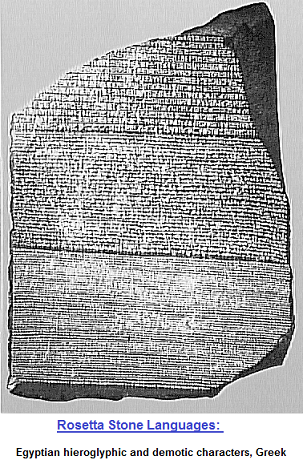 Rosetta Stone |
 Indian Ocean in the Balance |
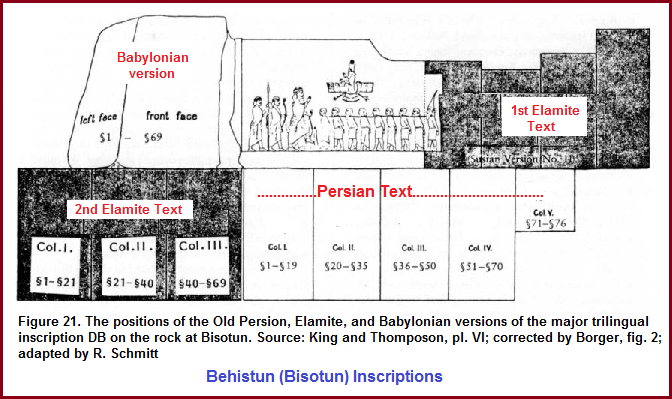 BISOTUN iii. Darius's Inscriptions | |
(See page 1 of the present series for an additional reference to infant babbling and the 2 versus 3 orientation: Study of Threes page 1)
However, it is not to be misunderstood that a "Study of Threes" means a research interest which excludes recognition of other patterns. Recognizing and listing different forms of "threes" from different subjects also includes recognizing and listing its absence. For example, it is necessary to make note of the fact that observations deduced to be an other-than-three pattern are related to the "three" as being another representative model of the overall human state of mental activity, sometimes referred to as human cognition, neural mental activity, or brain mapping, depending on the language one cares to employ in their research interests. Yet, in the development of a chart which outlines the quantity of different number patterns which helps us to discover that there are many patterns-of-two as there are patterns-of-three, we come to identify that some enumerated patterns are not as wide-spread in different subject areas, but may be particularly abundant in one or a few subjects that one or another individual comes to over-emphasize as THE telling point, such as many theologically-oriented people do. While some cultures may indeed use one pattern number more so than another, or at least initially appears to do so because this idea is part of the culture's urban-like assumptions about itself— or assumptions about another culture, this may not in fact be the case when looked at more closely... (by researchers trying to avoid anointing partisan treatment thereto).
Nonetheless, the suggestion that we can see a particular pattern if we are actively looking for it, belies the fact that such a pattern does not show up as often as we may be eager to find. There are numerous exceptions but these exceptions frequently reveal themselves to be inter-connected into a larger enumerated representation illustrating a cognitive architecture of humanity that is being overlooked (like archaeologists, anthropologists, historians, chemical evolutionists, etc., being unable to recognize surviving remnants of a "living fossil" because they are standing on it in terms of daily usage that they take for granted). No less, most patterns do not exhibit large numbers (quantities), and not all available numbers are routinely used (with respect to the many trillions our sequence of numbers can provide for usage). There are limitations, and these limitations are a study in itself.
It can not be over-emphasized that those interested in using numbers, geometric designs, and other tools for developing lists to make comparisons from, whether the information is used in a strict sense for application to an economic venture or purely for investigation in an effort to develop a discipline that may or may not eventually be found to exist as a worthwhile endeavor— as an application from which humanity might profit from; such researchers are likely required to have multiple interests, though one or two or three may stick out as having a particular preeminent recurrence in their discussions. As for myself, I am considered to be a generalist, though my level of generality sometimes exceeds the knowledge base of those whose efforts are singularly oriented in one direction of interest... even though their singular focus may afford them with an ability to apply their energies towards creating some measure of pecuniary income such as being an educator attached to an institution of learning. For those readers who think that being a generalist means you can never specialize... never be a professional or expert and are therefore too ill-equipped to relate to real-world circumstances as they exist in a given era; it is appropriate at this point to make mention of an article on the topic of a person being a Generalist, otherwise described as a Polymath: People Who Have "Too Many Interests" Are More Likely To Be Successful According To Research.
Necessarily so, it is of a deep research need to point out that in creating a list-of-threes, one encounters different patterning groups and singularities that must also be taken into account in order to get a better grasp of where and how... if not why— in the totality of all patterns, the "three" appears to play a large part... such as in everyday three-patterned expressions... some of which have a long history. (For example: Home-Sweet-Home; Blood, Sweat and Tears; 24-7-365; Hi Ho- Hi Ho, It's off to work we go, etc...) In making a list of threes, we may well begin to make lists of other non-three patterns, thus creating a larger mapping of human thinking. Thus, one may or may not appreciate their "Threes" (or other number-based) research task as an unrecognized domain of Cognitive Science.
Cognitive Science explores multiple subject areas in order to develop a result to be applied to current problems in different fields of interest. However, in a "Threes Research Journal" approach, we are at present simply compiling different patterns as one might begin sorting puzzled pieces for the sake of knowledge acquisition. One might refer to research as detective work, if they are so inclined. Taking the information and applying it to some commercial, political or religious use is not the primary consideration. Because we do not know the overall shape of the human mind/brain in its functioning (despite the controversial mind/brain philosophical problem), we can not say whether the edge and corner pieces are straight and/or curved inward and/or outward. The list of threes, twos, fours, fives, etc..., is a preliminary attempt to sort the pieces of the cognitive puzzle into groups called lists, though the sorting process itself is at present quite crude. Numerologists are number detectives but their research interests, as indicated by their web page applications and emphasize, routinely express a superficiality because they are often inclined towards commercialized ventures as an entertainment value. Apparently, most numerologists do not investigate number patterns in the intricacies of multiple scientifically oriented disciplines. They remain particularly superficial... if not in their research approach then in the resulting conclusions being suggested.

Cognitive Mapping
Constructing a map of cognitive activity using a number-value arrangement is much like using a dot-to-dot approach to create a picture. When we discover that the "three" intersects frequently with "two" and it with one or more other number values, the dot-to-dot process gives the impression of a spider's web or other lattice work. Then again, even while attempting to construct the lattice of the mind, taking stock of the list of different groups indicates a limitation of activity, though a brain with billions of cells would suggest billions of interactive occurrences. This may not be the case. Even though billions of neurons may come into play, the resulting usage is an expressed limitation of interaction.
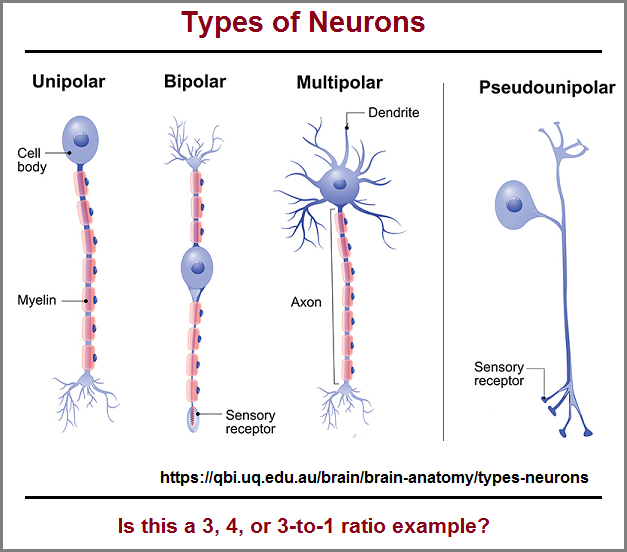
Types of Neurons
While the human brain may use hundreds of patterns-of-two and patterns-of-three that may or may not interact with other patterns, we do not find a regular usage of higher number values such as groups of 101, 257, 861, 2,358, etc... In other words, the groups or "chunks" of brain usage do not exceed a given low number value just like that we find in memorization techniques and the counting systems of both primitive peoples and animals. However, it must be remembered that memorization involves three issues involving its counterpart:
Forgetting is either:
- The failure/inability to store information in the first place.
- The failure/inability to retrieve the information.
- The failure/inability to store information in such a way that it can be found when needed.
Memorization Techniques
When higher (number/information) values come into play such as the value "trillions", we must note the prefix of the word is "three" oriented (tri-llions), not to mention we would group it with billions and millions, thus creating another group-of-three as if something has imposed such a pattern of (three) usage on the human brain. Patterns-of-two have also been used such as described by the complementarity illustrated by the yin/yang ideology of old which many interpret as a dichotomy and/or duality in the sense of being opposites that are or are not inter-related depending on one's context and inclination for interpretation. While the view of "7" has some advocates, its presence is not as wide-spread when a survey of multiple subjects is undertaken... it is merely over-emphasized and this over-emphasis has been suggested as being of a religious origin coupled to early astronomical observations without the usage of a telescope. There are numerous internet sites regarding the number seven, yet the examples being provided are frequently quite simplistic and do not provide for the relationship of the number seven to the frequency of other number patterns nor describe the number seven as an expressed limitation in the overall scheme of human usage of particular number patterns with respect to human cognition in an incrementally deteriorating environment which forces the human animal to adopted strategies as attempted coping mechanisms related to homeostasis (equilibrium) in terms of a survival mechanism. Clearly, if the "7" is as valuable as some claim, then we might expect to see it in the placement of the Earth in the seventh position instead of the third, and that DNA as well as RNA would have a Septuagint or hepta code instead of a triplet one, and most people would use seven fingers to hold a pen or pencil instead of three. Here are some examples of links:
- The Significance of the Number Seven by By Rabbi Dr. Hillel ben David (Greg Killian)
- Seven Reasons We Are Captivated by the Number Seven by Guy Winch Ph.D.
- It has been significant since ancient times. (Yet, not as ancient as the "three" in DNA or the position of the Earth.)
- It has had significance in almost every major religion. (How does one define "major"?)
- It is associated with luck and magical properties. (So are a variety of other numbers.)
- It matches our memory capacity. (Capacity perhaps, but not necessarily the chunking method.)
- It fits our attention spans. (Whose attention span? Those in an electronic driven culture or more primitive culture?)
- It is a prime number. (There are lots of prime numbers.)
- It is the most popular number. (One must wonder if this is culturally induced, or we must distinguish from a number that is chosen and that which is actually used, but not consciously acknowledged.)
- The magnificent 7: The meaning and history behind the world's favourite number by Anna Pukas
- What’s so special about the number "7"? by Peter Degraaf
- Numberopedia: Number 7 in Government and History
- (1858) The Number Seven By Hames Hadley, LL.D.
- What are some great facts attached with number 7?
While some readers may conclude after attempting to put together a list of "7's" that it "goes on and on", this statement actually reflects a limitation of effort expended in collecting such a suppose "on and on" list. The three-patterned phrase "on and on" is like a primitive referring to "many" or "lots" or "several". In fact, what appears to be occurring is that when one encounters examples of the number 7 they become accustomed to accepting the repeated notion that there are lots of examples... yet there are actually only a few that get repeated in different ways and there is no relevance being established as to the character importance of the examples. Some of the examples in any number representation can be viewed as being less valuable than others, if one should take the time to make a comparison. For example, the number 7 on a person's sports jersey is not as important as our usage of the 7 day week categorization. Likewise, the 7 day week classification is not as important as the Earth being in the 3rd position from the Sun nor when compared to the three large particles of atoms.
In some instances, the "many" label might well be used as an acceptable replacement for any quantity beyond the number 3 quantity or even the value "7" in a given person's own varitye of mental gymnastics; an assignment that requires just a few examples to convince them of some supposed ubiquity and universality, if not dominance and superiority if one associates some religious affiliation to the value.
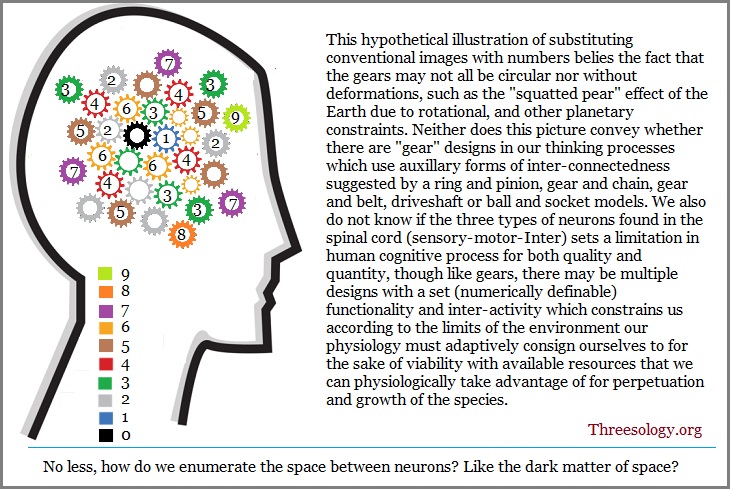
Trying to discover what has created a condition that forces the human brain to use a "chunking" methodology which subscribes to the usage of low values, may help us to develop a means by which the human brain can be expanded... though an expanded human mind might well seem quite odd, if not dangerous, to the human mind which has mappable limitations... within the present scope of maps being used to outline a person's presumed abilities such as in the case of college entrance exams, I.Q. tests, and other testing models. The thinking processes of such an individual might well appear to be quite strange and unfathomable to "normal" people with an "average" intelligence and knowledge base in a given social, educational or workplace setting. They might in fact be labeled a different species just as some geniuses or those exhibiting some extra-ordinary skill or talent are sometimes humorously described.
While using a interactive "gear" illustrating as a map of human thinking is easily understood by many, others may strive for a more complex image of displayed interactiveness which appears to express what some believe to be the actual brain activity when judged by the hither and thither actions and distractions seen in human behavior. In other words, the behavior of people is rather an effect of scattered activity which may jump from one scenario to another without apparent rationality to some observers. If the activity appears to be too dislocated from any logical interpretation of a given observer, the person might well be labeled as childish, immature, crazy, insane, schizophrenic, bipolar, socio-pathic, psychotic, psycho-pathic, criminal, distracted, senile, demented, mad scientist, artistic, creative, method-to-their madness, eccentric, genius, dumb, idiotic, stupid, different, misfit, out of step, etc...
The usage of a planetary-like rotation model with some central neuron or group of neurons acting as the 'solar energy' source (so to speak), may conceal that there is not central command post, though basic physiological functioning suggests there must be a point of origination... even if afterwards neurons are active in an idling motion. The usage of gears may cause perceptions to think in rotational schemes of consideration for mental activity, and keep some from considering alternative activities such as oscillation, vibration, fulcrum balancing, ping-pong or pin-ball episodic characterizations. In other words, though we count sequentially from zero to nine, and may substitute the conventional images for numbers, this need not imply that neurons inter-act in a static formula of interaction. Indeed, adaptability suggests otherwise. Some degree of flexibility is noted by the different languages being used as well as being able to copy and then exceed old standards of design to create original variations or some totally new representation. Yet, nonetheless, an underlying premise based on what can be imagined to be a simple number value must be present. Whether the sequence is from zero to one or one to three, or three to nine, etc...
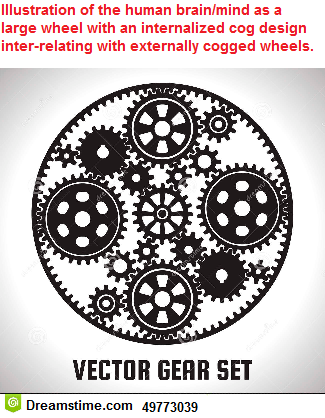
While some may visualize the mental or brain activity of an individual in term so interacting gears, the parameters of the brain/mind within the fixed barrier of a skull must be taken into consideration. If we conceive of the brain/mind as a system of cogged gears then we may want to additionally consider that the skull is an internalized cogged wheel, that can be imagined as a clock with a working system of gears. Then again, because the mind/brain interacts with its environment (as a system of gears itself), we might want to consider each person as a wheel or even a single cog on a much larger wheel within the planetary system as a system of wheels within a galactic system of wheels within a Universe of interacting wheels. However, here once again we approach a point in which we come to consider whether the Universe has both an internal and external system of cogs. In other words, does the Universe interact with a system of gears unthought of? While the image is rather simplistic, it nonetheless provides a model by which to begin some measure of contemplating why the overall system uses a finite system of patterns, one of which is the human species... as well as physics, chemistry, etc... Why do only a select number of patterns repeat? Why limit humanity to a handful, and why do we have the handful that we do to use repeatedly? Why are we inclined to describe time in a three-patterned sequence of seconds-minutes-hours, and that an effort to think more complex... we then design another pattern-of-three in the fashion of days-weeks-months, or years-decades-centuries? Indeed, by viewing the sundial as an early timepiece, we can't help but distinguish the presence of a single "hand" telling us the hour of the day time. Later time pieces then illustrated a "hand" describing the minutes. Further development gave us the second "hand".
The following set of images using the same profile are meant to provide some visual representation of the 1-2-3 developmental scenario and not suggest that this is how the event actually occurred in history, since one-two-three scenarios can take place in different time periods amongst different cultures who may or may not be aware that their activity of design had been duplicated and progressively altered.

While there are several webpages describing the history of timepieces, you won't come across information regarding the development of the number of hands being used as an expression of cognitive science. This is due to the situation that those compiling the information are not reviewing history in terms of a 1- 2- 3- maturational development or other comparative sequencing methodology, such as the developmental occurrence of one, and then two, and then three Germ layers occurring from simple to more complex life forms.
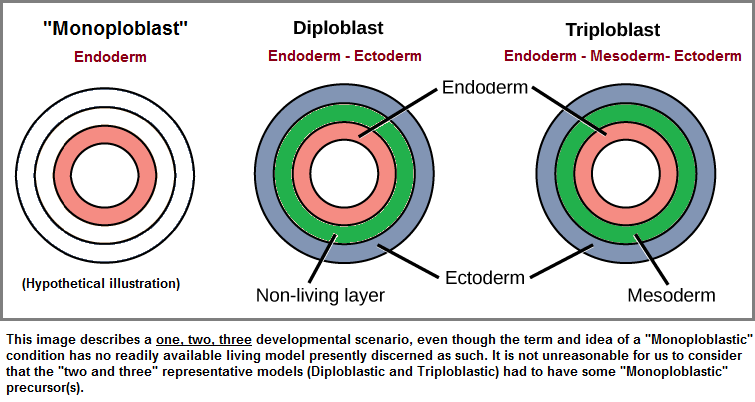
While there may be some interest in documenting transitional stages, these stages are not necessarily recognized as containing basic patterns which can be identified and supplemented with basic patterns that enable an investigator to pay witness to the same basic patterns occurring elsewhere, when the (metaphorically described) clothing and colors and language of different time periods in different cultures of various subjects is concentrated as an expression in an effort of removing bias... though the usage of certain symbols in one's chosen method of analyses is a bias in itself. In other words, they don't use a study of "threes" as a tool by which to analyze and identify the presence of patterns to be compared, associated and cataloged across multiple subject areas. They don't recognize the recurrence of similar patterns as an identifying marker of human cognition... its progress, regression, repetition, redirection, substitutions, digressions, stagnation, deterioration, etc...
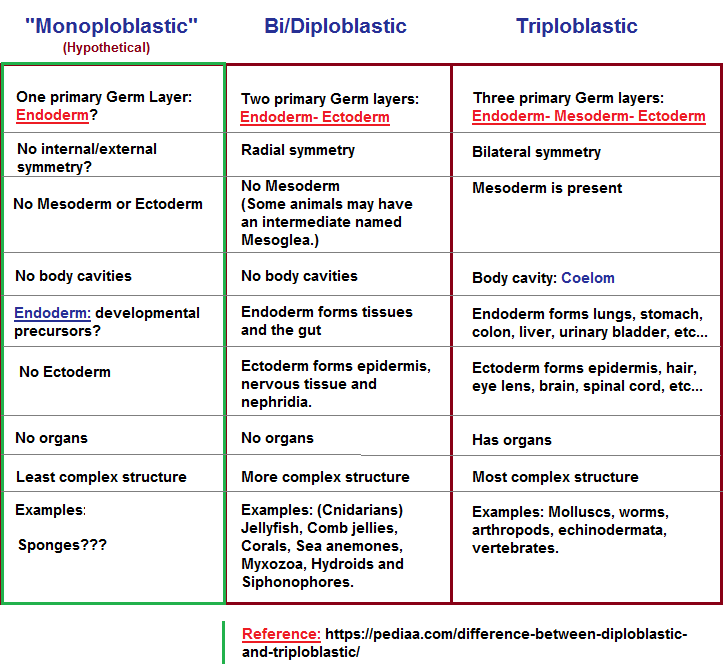
With respect to the usage of sponges as an example, a reference may be helpful for those interested in this area of research:
The evolutionary origin of gastrulation defined as a morphogenetic event that leads to the establishment of germ layers remains a vexing question. Central to this debate is the evolutionary relationship between the cell layers of sponges (poriferans) and eumetazoan germ layers. Despite considerable attention, it remains unclear whether sponge cell layers undergo progressive fate determination akin to eumetazoan primary germ layer formation during gastrulation.
Evolutionary origin of gastrulation: insights from sponge development
While creating a map of the mind/brain to identify some universality or relative constant is rewarding for some in their respective research and application interests, the creation of such a map does not mean we can then illustrate a path to create a convention of thought whereby some ideology can be imposed or impressed upon all others for a given result... such as bringing about peace, increased intelligence, etc... We may be able to go from point A to point B or several other points of interest such as when one travels by car, boat, plane, bicycle, imagination, etc., yet not all the points are affected by the travel. For example, a single neuron's activity may travel abroad to several other neurons, but not all neurons are thus affected. Isolation takes place which may or may not create a condition such as described by the effects of a communicable disease, war, accident, weather anomaly, etc...
While one could cut a map in half just like removing the corpus Callosum between the two brain hemispheres, the functionality is having two maps constrained by one body. And even when there is no severance of the corpus Callosum, we describe the functioning of the human brain in a colloquial way by saying we only use 10% of our brain. While most people use more than 10%, the portion they do use may not be concentrated onto a single focus... their thought processing is a socially accepted randomness that during different eras may well be viewed as mental illness in other eras. The following image may appear to be the illustration of an interactive randomness with an underlying logic constrained by the values of water, energy, and food, it also describes what some believe to be a complexity that is difficult to unravel... unless the defining characteristics of the parameters are not identifiably isolated in order to create some model of measurement which necessitates the usage of numerical values in an effort to preclude distractions caused by conventions which can be interpreted in multiple ways, such as asking a group of people to define the words love, peace, freedom, strength, wealth, intelligence, creativity, etc...
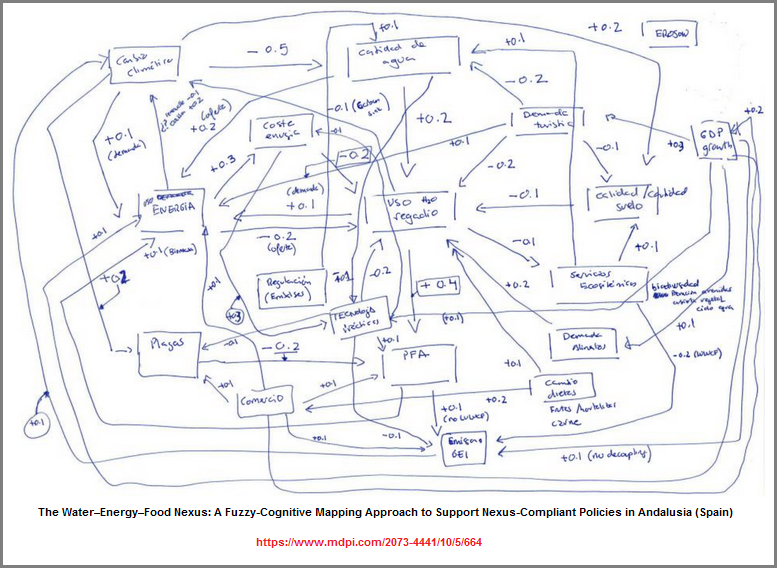
The Water Energy Food Nexus
In creating a list-of-threes, the encounter of another pattern nearby or intersecting with the pattern-of-three must be noted. If the interaction continues and it encounters another pattern, it too must be inter-linked, as well as provide an acknowledge indication what pattern(s) don't readily appear. We must note the frequency and quantity of occurrences, and an assigned with an unbiased qualitative consideration as one is able to within the value system they are using. Though one might strive for complete honesty in their research work, biases necessarily crop up, be they religious, cultural, racial, gender, political, etc... Because we are exposed to cultural and familial biases from birth, it is often difficult to subvert or circumvent the ingrained impulses to provide an accurate interpretation. Then again, the perceptions of others reading your efforts will necessarily use the lenses of their own biases to make an interpretation and create a value judgment.
By compiling lists of different patterns, we might well be able to identify changes in human brain processing by noting the changes (if any) of the lists. For example, is one pattern being used more than another and is this different from a previous period of accountability? Are the patterns being adopted and adapted by different generations without any actual increase or decrease in frequency of usage? Why does one culture appear to prefer one pattern over another, yet may even be unaware of their usage? If we say that numbers suggest progression, then why don't later generations use progressively higher number patterns in their expressions and everyday lives? It matters not if a culture has many thousands of words compiled in dictionaries, if their is an overall limit as to the quantity of words being used. The limitation of vocabulary usage are well identified in the language being used in newspapers, magazines, television shows, religious documents, scientific journals, movies, advertisements, etc... The thousands of words belie the fact that the English language is limited by 26 letters and 10 numbers. However, the presence of limitations is a topic of research suited for another time and place.
Like the presence of different neurons, though the brain may have multiple types of brain cells, we humans are inclined to devise a means by which they are categorized into some groups or "chunks", like grouping numbers into sets-of-three and separating them with a comma such as ones/tens/hundreds (comma), thousands/ten-thousands/hundred-thousands (comma), etc...
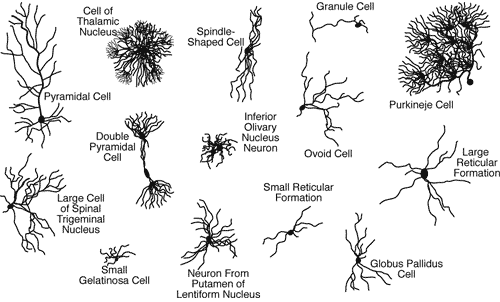
How many different type of brain cells are present in human?
With respect to glial cells, the value of "seven" is used to describe the totality, yet under a small measure of examination, one can see this arrangement broken down into a 4/3 arrangement. Further analyses might reveal distinctions creating smaller groups as well, such as by shape, functionality, proximity, etc... While some prefer generality, others prefer more specificity. Then again, do we simply count all the individual groupings, or settle on one because we are inclined to adopt a singular pattern of over-riding interest, be it 2, 3, 7 or otherwise?
Glial cells are also broken down into seven types:
CNS (Central Nervous System )
- Astrocytes: cells that maintain a neuron s working environment
- Oligodendrocytes: provide support and insulation to axons in the CNS
- Ependymal cells: create cerebral spinal fluid (CSF) and line the ventricles of the brain
- Radial glial: capable of generating neurons, astrocytes and oligodendrocytes
PNS (Peripheral nervous system)
- Schwann cells: provide support and insulation to axons in the PNS
- Satellite cells: surround neurons in the sensory, sympathetic and parasympathetic ganglia and help regulate the chemical environment
- Enteric glial cells: found in the nerves in the digestive system
There are studies recently where scientists have found more types of brain cells at a molecular level.
- New kinds of brain cells revealed
- Making A Better Brain: Scientists Just Discovered a New Kind of Brain Cell
Here's another way of compiling the different types of glial cells, using a 2 by 3 configuration:
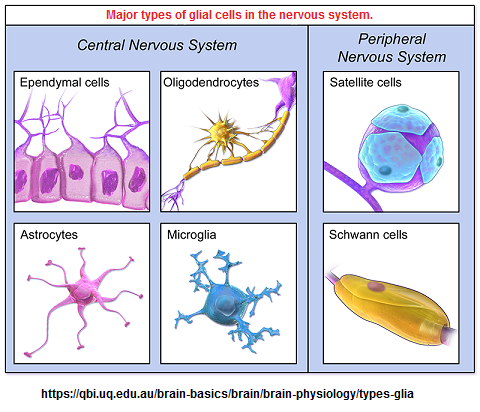
Yet, in getting information to a brain that is sometime characterized as a Triune brain, we find that the sensory tracts frequently reveal a three-part composition such as the iris-cornea-pupil of the eye (not to mention the three types of cones and 1 type of rod assembly). Interestingly, there is mention of research involving the ratio presence of the three cones, but the 3-to-1 ratio of cones and rods compared to other 3-to-1 ratios in other subject areas has little research focus because this relationship is overlooked by standard forms of Cognitive Science approach. For example, the 3-to-1 ratio found in DNA and RNA: Both have Adenosine-Cytosine-Guanine, but separately have Thymine and Uracil. Hence, the knowledge of the Triplet coding should be included with a larger knowledge base involving the 3-to-1 ratio since the human mind appears to compartmentalize constructs into a 3-to-1 pattern such as for example the 1 space shuttle with three engines or 3 colors in 1 street light, or three eating utensils (Knife-Fork-Spoon) and containers (plate-bowl-cup) that may be used at each meal... though such uses may be subverted by a fast food 3-in1 "combo" meal (sandwich-beverage-French fries [or some other side order]). And let us also mention the three layers of skin (Dermis-Epidermis-Subcutaneous) for touch, as well as the several "threes" found in the human ear:
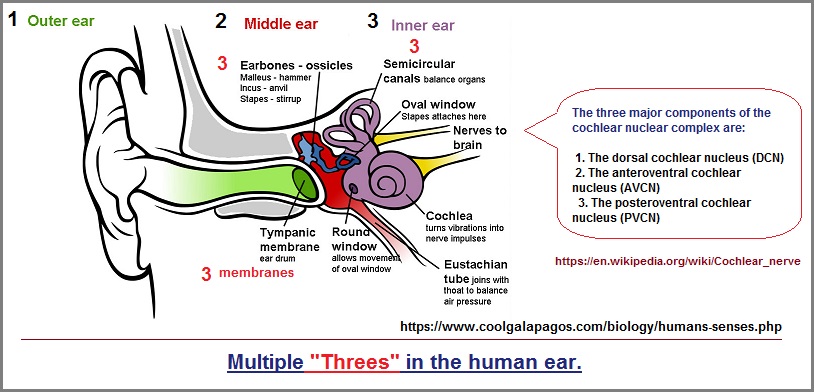
One must consider whether the presence of multiple "three" patterns in the human ear has a dominant influence on speech, which by extension brings to mind the idea that speech has an influence on thought processes, thus leading us to further consider how and why thought processes become focused on conceptualizing in numerically identifiable patterns, for example, that may be labeled duality, dichotomy, trilineal and quadralineal, (or differently labeled as triad, quadruple, etc...). Yet, another consideration involving speech is how it may play in determining which of the physiological senses comes to dominate: Your Most Important Sense Depends on the Language You Speak(by Reuben Westmaas).
If the structure of the ear does influence speech which does influence thought, then can we map physiological differences by compiling an enumerated list of speech patterns with or without associating cultural ideas as an accepted convention in some research models? Does a "threes Research" model enable us to detect subtleties that other research models can not?
Instead of using an inter-connecting gears model of a cognitive map as simplistically illustrated in the image above, how about replacing the gears with dots and assigning numbers to them in a simplistic dot-to-dot inter-connectivity model? Since the ideas represented by images can be reduced to numbers, the presumed attributes of the brain hemispheres portrays a different picture:
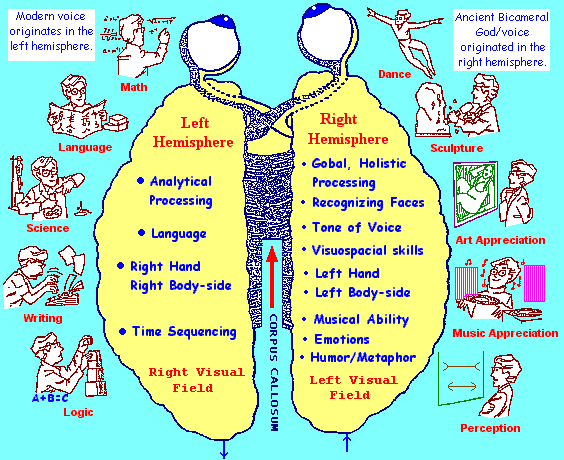
***Note: Much of the brain illustration shown above was adapted from page 106 of Dean Falk's book entitled "Brain Dance," 1992.
When we look at the assigned culturally recognized attributes of the brain, we can see a distinct (over-lapping) 1-patterned, or 2-patterned, or 3-patterned arrangement. (Reminder: when a person gets a stroke in the left hemisphere of the brain it affects the right side of the body, and vice-versa.)
|
Left Hemisphere (Predominantly 3-patterned) Math: Associative Commutative Distributive Logic: Major Premise Minor Premise Conclusion Time Sequencing: Seconds ~ Minutes ~ Hours Past ~ Present ~ Future Day ~ Week ~ Month Language: Subject Object Verb Right Body Side: Tri-cuspid heart valve Three-lobed lung |
Right Hemisphere (Predominantly 2-patterned) Holistic: Macro versus Micro Whole versus Part Inner versus Outer Music: Major Scale vs Minor Scale Loud versus Soft (Quiet) Consonance vs Dissonance Visuospatial: (Art) Background vs Foreground Light vs Dark (Contrasts) 1 Dimension vs 2 Dimensions Emotions: Pain versus Pleasure Positive vs Negative Love versus Hate Left Body Side: Bi-cuspid heart valve Two-lobed lung |
|
(Reptilian) (Predominantly 1-Patterned) (Self)-Preservation~ (Self)-Procreation~ (Self)-Preeminence | |
Interestingly, by noting that when a person has a stroke on one side of the brain the other side of the body is affected. Hence, the right and left enumerated portions of the hemispheric distinctions can also be found in the heart and lungs. I do not know why other parts are not as obviously configured. Specifically, the heart and lungs exhibit "2" and "3" patterns corresponding to the sides of the body they are on:
 The correlations of two and three being made on this page are not typical considerations. However, I did come across two references concerning the bicuspid and tricuspid valve differentiations (even though the explanations do not actually provide anything but suppositions that amount to conventional ideas border on wives tales and urban legends): | |
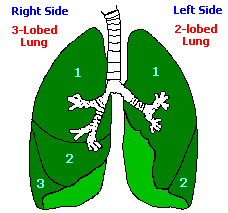 Here is the supposed reasoning why the lungs have different quantities of lobes:
However, it should be noted that there are Morphological variations of the lungs: (a study conducted on Indian cadavers); with the quantities of 1, 2, 3 (and sometimes 4), that can help to produce a mental image of a graph if one is so inclined from the following information:
In recognizing that the left lung is smaller than the right lung (which provides room for the heart), let us conjecture that this is due to some past earlier developmental sequence just as we find the 1-layer, 2-layer, 3-layer sequential development of the 3 primordial germ layers (Ectoderm - Mesoderm - Endoderm) in primitive -to- more complex organisms. Hence, difference in size (dimorphism) as well as a two/ or three prominence may provide another link towards understanding developmental processes. Does this mean that the recurring smallness of the female to the male in many species indicates that females came before the male in terms of species-specific evolutionary development during particular environmental circumstances? If so, will there be an increased development towards a 3 to 1 "fusion" ratio? |
(Above idea also found at:)
As noted above in the lung, a "Threesological" research approach involves an awareness of other Anatomical Variations which must be included in the development of a composite cognitive map. These variations, even though some are widely recurring and thus appear to be what is described as "normal" because of a wide-spread occurrence (such as when looking at the sense of smell and sense of taste), need to be kept track off over time, just as we do to keeping a log of weather patterns and occurrences of anomalies such as tornadoes, typhoons, earthquakes, solar flares, sink holes, etc... Interestingly, research models in the dissection of our senses very often involves some aspect of a "three" configuration such as three trials, three-month/year period, three subjects, three researchers, three tests, etc... When looking at the different senses, we must make note of which part of the brain they predominantly connect with, such as the link between smell and the primitive brain. We also need to identify how multiple areas and physiological characteristics interact such as in the primitive sense of touch in relation to the skin as an originating organ of the body.
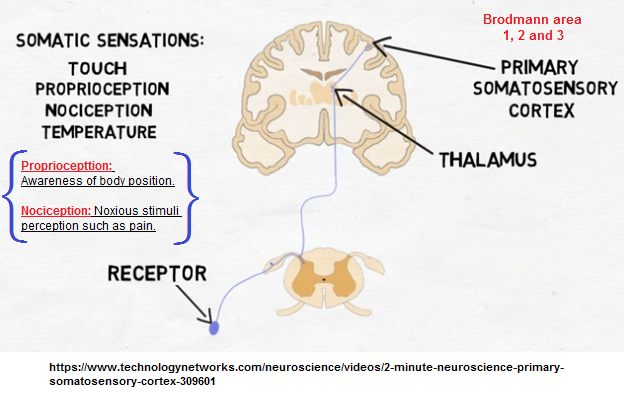
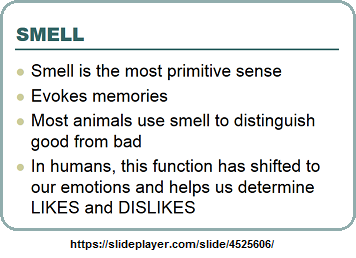 |
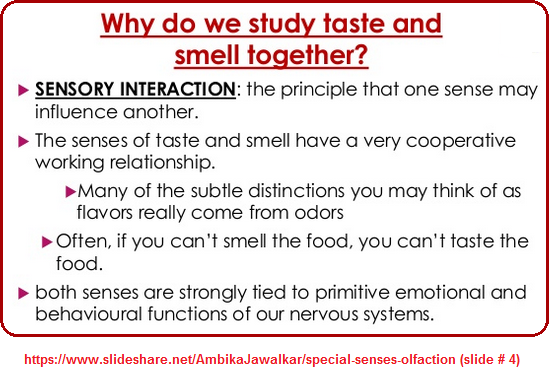 |
 |
|
While some may think that variations of organs and other physiological components are a type of wrench that can be thrown into a categorization of enumerated examples being compiled so as to offer an argument against a particular recurring value; we must further note that the variations themselves also exhibit the same enumerated limitations as the predominantly occurring examples. Hence, whatever is causing the limitations of human concept formation also creates a limitation in the variations of physiology. What is causing the imposition and is it a stable influence? Or is the influence on a course of degradation just as the planetary system is incrementally exhibiting... suggesting an accountable demise of the human species and all other life forms?
Page initially created: Saturday, 8th June 2019... 3:59 AM
Page initially posted: Monday, 12th June 2019... 6:36 AM
Page updated: Wednesday, 27th January, 2021... 8:23 AM
Herb O. Buckland
herbobuckland@hotmail.com